Lisbon's Beach Paradise Awaits!
Costa da Caparica is a coastal town in Portugal, known for its long sandy beaches, relaxed atmosphere, and proximity to Lisbon. It attracts surfers, beachgoers, and visitors looking for an easy escape from the city.
JBS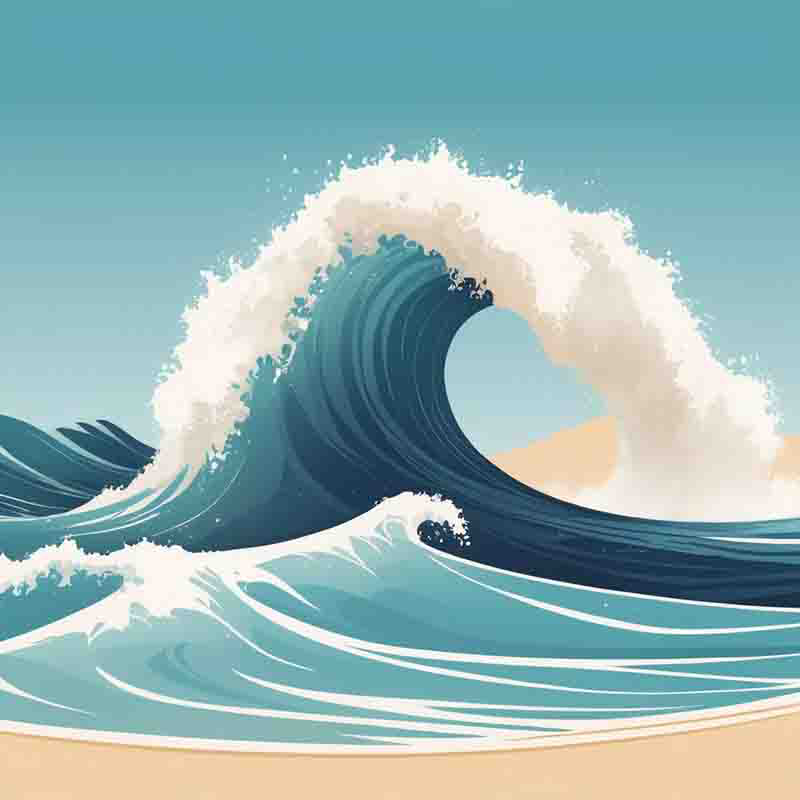 Beta Version
Beta Version
Costa da Caparica is a coastal town in Portugal, known for its long sandy beaches, relaxed atmosphere, and proximity to Lisbon. It attracts surfers, beachgoers, and visitors looking for an easy escape from the city.
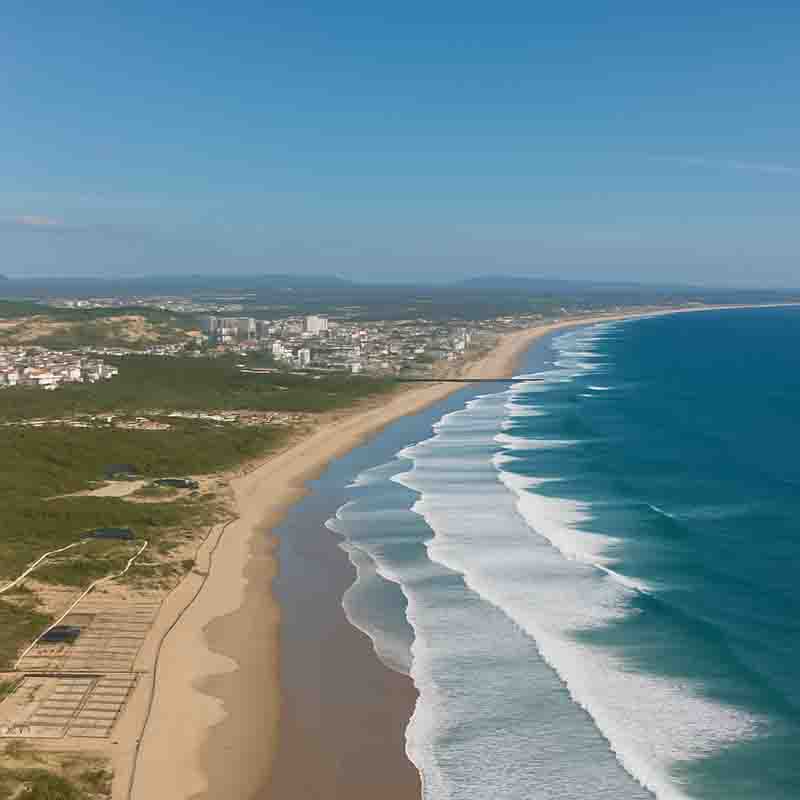
Whether you're looking to catch some rays, try surfing (the waves look fantastic!), enjoy fresh seafood at a beachfront restaurant, or simply take a long walk by the ocean, Costa da Caparica is a must-visit. It's so close to Lisbon but feels like a whole different world.
Costa da Caparica is about 15 kilometers south of Lisbon, across the Tagus River, and belongs to the municipality of Almada.
The coastline stretches for over 26 kilometers, offering multiple beaches with different characteristics along the western side of the Setúbal Peninsula.
From Caparica to Cabo Espichel, fine white sands meet wide expanses of eucalyptus, pine, and acacia trees, creating one of Portugal’s most accessible and striking beachscapes.
Are you looking for the perfect beach holiday? Costa Da Caparica features endless stretches of golden sand, incredible surf and fresh seafood.
26 km of Beautiful Beaches: Sunbathe, surf, or take long scenic walks
Quick & Easy Access: Just a short drive or ferry ride from Lisbon
Incredible Food & Views: Enjoy fresh seafood right by the ocean
Laid-Back or Lively: Find both peaceful retreats and vibrant nightlife
Whether it’s a quick visit or an extended stay, you deserve a getaway filled with sun, sea, and unforgettable moments.
Must-Do Activities: Experience the best of Costa da Caparica by enjoying thrilling surfing and water sports, exploring the scenic nature trails and hiking routes, and taking a memorable boat tours with opportunities for dolphin watching.
Best Time to Visit: Costa da Caparica offers different experiences throughout the year: spring and autumn provide ideal weather with fewer crowds, while summer comes alive with bustling beaches, festivals, and various events. For those seeking tranquility and excellent surf, winter offers quiet, uncrowded beaches.
Accommodation: Find your perfect home away from home in Costa da Caparica. Whether you're seeking beachfront hotels with stunning ocean views, cozy apartments for a self-catered stay, or budget-friendly hostels for a social vibe, you'll find a range of accommodation options to suit every taste and budget.
Getting Here: Getting to Costa da Caparica is easy with several convenient options: it's just a quick 15-minute drive from Lisbon, or you can take a direct bus route from the Sete Rios station. For a scenic journey, consider taking a ferry to Cacilhas followed by a short bus ride to your destination.
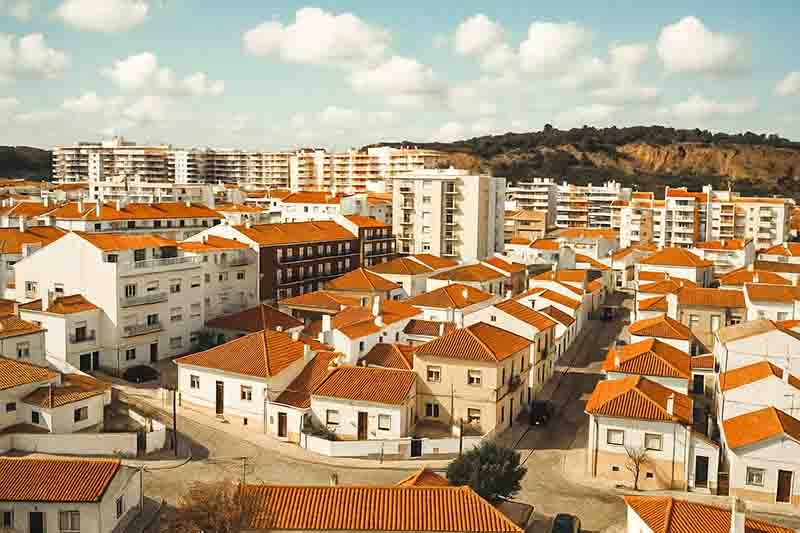
With easy access to beaches, transport links, and local amenities, Costa da Caparica delivers a balanced lifestyle ideal for families, retirees, and second-home owners.
Costa da Caparica is emerging as a strong player in the real estate market near Lisbon.
The area combines a relaxed coastal lifestyle with modern apartment buildings, traditional homes, and local shops, all within easy reach of the beach.
Popular with families, retirees, and Lisbon commuters, residential Costa da Caparica provides a quieter alternative to the city while maintaining good transport connections.
The area is popular for its powerful Atlantic waves, making it a haven for surfers and kitesurfers.
Costa da Caparica is home to a wide choice of seafood restaurants, beach bars, and cafés serving fresh fish, grilled sardines, and local specialties like "amêijoas à bulhão pato" (clams in garlic and cilantro sauce).
Beyond the beaches, visitors can explore the Arriba Fóssil da Costa da Caparica, a protected area with cliffs and hiking trails.
The town also hosts summer festivals and live music events.
A small tourist train, the Transpraia, runs along the coast in summer, providing access to less crowded beaches.
The warmest months are from June to September, with temperatures between 25-30°C.
Spring and autumn offer mild weather with fewer crowds.
Winter is cooler but still pleasant, attracting surfers and nature lovers.
Costa da Caparica is a playground for outdoor enthusiasts, offering a wide array of recreational activities to suit all tastes.
Surfing: With consistent waves and several surf schools, Costa da Caparica is a popular destination for surfers of all skill levels.
Beach Volleyball: A vibrant scene with local clubs and tournaments, attracting players and spectators alike.
Sunbathing and Swimming: The extensive sandy beaches provide ample space for relaxation and enjoying the Atlantic waters.
Hiking and Biking: The Arriba Fóssil nature reserve with its picturesque hiking trails and breathtaking views of the coast is yours to discover.
The abundance of recreational activities ensures that visitors to Costa da Caparica have endless opportunities for fun and adventure.
Costa da Caparica is an easy-to-reach destination with long beaches, good surf, and fresh seafood. It is a great choice for a day trip or a weekend away from Lisbon.
Costa da Caparica is located on Portugal's western coast, just 15 kilometers from Lisbon across the Tagus River.
The area features a continuous 26-kilometer stretch of sandy Atlantic beaches, making it the longest uninterrupted beach area near Lisbon.
It's easily accessible from Lisbon via the 25 de Abril Bridge by car (20-30 minutes) or by public transportation (bus or ferry to Cacilhas then connecting bus).
Costa da Caparica began as a fishing village before developing into a popular beach destination that maintains much of its authentic Portuguese character.
The beaches are divided into sections with different characteristics: Praia do Norte (popular with surfers), Praia de São João (wider beach area), Praia do CDS (water sports hub), and Praia da Rainha (more secluded).
It's recognized as one of Portugal's premier surfing destinations, with consistent waves year-round and numerous surf schools offering lessons for beginners.
During summer months (May-September), a tourist train called "Transpraia" runs along the coast, connecting the town center with beaches up to 10 kilometers south.
The best time to visit for beach weather is May through September, with July and August being the most crowded and expensive months.
The town specializes in fresh seafood restaurants serving traditional Portuguese dishes like grilled sardines, bacalhau (salted cod), and caldeirada (fish stew).
The Arriba Fóssil da Costa da Caparica Nature Reserve protects the cliff formations backing the southern beaches and offers hiking trails with coastal views.
Accommodation options range from beachfront hotels and apartment rentals to family-run guesthouses and camping sites near the southern beaches.
Beyond beaches and surfing, the area offers activities including paddleboarding, fishing, hiking, beach volleyball, and cycling along dedicated coastal paths.
Historically dependent on fishing, the economy of Costa da Caparica has undergone a significant transformation. While fishing remains an important part of its heritage, tourism has become the primary economic driver.
From a fishing village, Costa da Caparica gradually evolved into a popular tourist destination throughout the 19th and 20th centuries, drawing visitors to its extensive beaches.
| Year | Milestone |
|---|---|
| Prehistoric Era | The Arriba Fóssil da Costa nature reserve contains geological formations dating back millions of years, indicating early natural activity in the region. Evidence suggests the area was once part of a larger coastal ecosystem. |
| Roman Period (1st - 5th Century AD) | The Romans occupied much of the Iberian Peninsula, including the Caparica region. Archaeological findings suggest some fishing and salt production activities took place along the coast. |
| Moorish Rule (8th - 12th Century) | During the Moorish occupation of Portugal, Costa Da Caparica was part of the region controlled by the Moors. The area was sparsely populated, mainly used for agriculture and coastal fishing. |
| Reconquista (12th Century) | King Afonso Henriques, Portugal’s first king, and later monarchs reclaimed the region from Moorish control. Small Christian settlements began forming around the area. |
| 16th - 17th Century | The coastline became important for fishing communities, with settlers relying on the Atlantic for food and trade. Salt production and farming were also common. |
| 1755 Lisbon Earthquake | The devastating Lisbon earthquake and tsunami impacted Costa Da Caparica. Many fishing communities were affected, and the coastal landscape was altered. |
| 19th Century | The village grew as a center for artisanal fishing. Fishermen used large wooden boats known as "saveiros", which required teams of men to pull the nets ashore. |
| Early 20th Century | The region remained a small fishing community but saw an increase in visitors from Lisbon. Wealthier families built summer homes, and the first beachgoers arrived. |
| Mid-20th Century (1930s - 1960s) | With the rise of beach tourism, Costa Da Caparica gained popularity as a seaside destination. Infrastructure improved, and small hotels and restaurants were built. |
| April 25, 1974 (Carnation Revolution) | Portugal transitioned from dictatorship to democracy. Costa Da Caparica, like other parts of Portugal, saw modernization and increased tourism. |
| Late 20th Century (1980s - 1990s) | The surfing scene began growing in Costa Da Caparica. More beach bars and tourist facilities were developed, making it a major weekend getaway for Lisbon residents. |
| 21st Century (2000s - Present) | Costa Da Caparica evolved into a well-known tourist hub, famous for its beaches, surfing, and nightlife. The boardwalk and beachfront infrastructure were expanded to accommodate growing visitor numbers. |
| Future Development Plans | The local government continues investing in eco-tourism, coastal preservation, and urban improvements to balance tourism growth with environmental sustainability. |
Once a quiet fishing village, Costa da Caparica grew into a popular coastal retreat over the years. Despite its development, you can still see remnants of its fishing heritage, especially with the "Arte Xávega", a traditional net-fishing technique still practiced today.
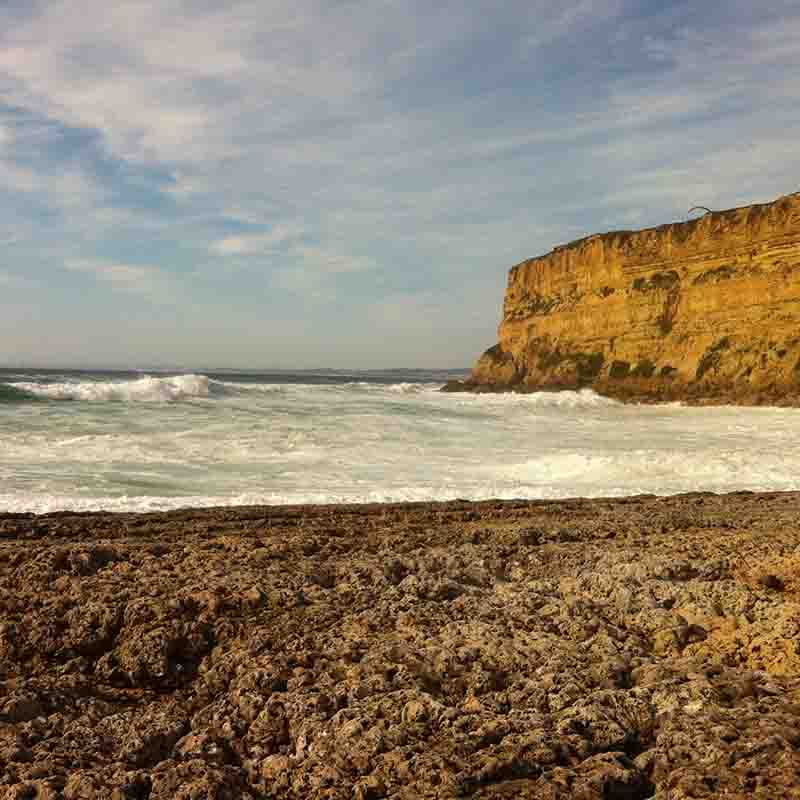
The rugged coastline of Costa da Caparica is a place of raw beauty, where the land meets the sea in a powerful and unforgettable embrace.
Costa da Caparica's proximity to Lisbon makes it an ideal destination for both tourists and locals seeking sun and sand.
A mere 15 kilometers, a 20-30 minute drive over the 25 de Abril Bridge, separate the town from the heart of Lisbon.
This convenient location allows visitors to enjoy pristine beaches while staying close to the amenities and attractions of Portugal's capital city.
For those without personal transportation, public transit options include regular bus services from Lisbon's Praça de Espanha.
Many visitors also enjoy the scenic route of taking a ferry from Lisbon to Cacilhas followed by a connecting bus to the beaches.
This journey takes approximately 45-60 minutes but rewards travelers with stunning views of the Tagus River and coastline.
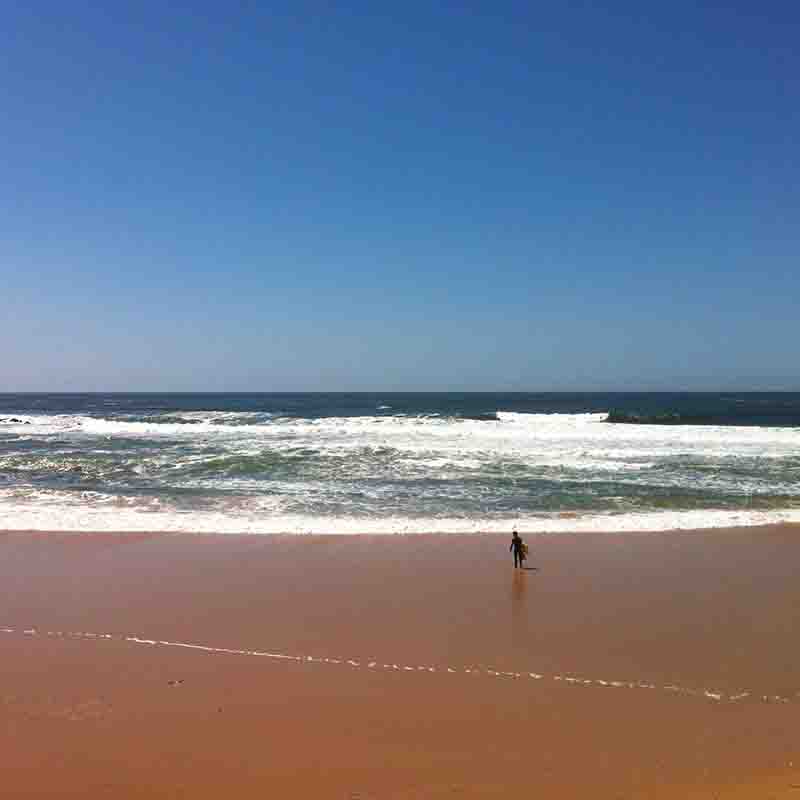
Portugal's Atlantic Beach Paradise Costa da Caparica stands as one of Portugal's most impressive beach destinations, offering visitors a perfect blend of natural beauty, recreational activities, and authentic Portuguese culture.
The main draw of Costa da Caparica is undoubtedly its impressive stretch of sandy beaches facing the Atlantic Ocean.
The extensive coastline includes numerous named beaches, each with its own distinct character and appeal:
Praia do Norte sits closest to the town center and has become a favorite spot for surfers due to its consistent wave patterns. The beach buzzes with energy, particularly during summer months, with music often playing from nearby establishments.
Praia de São João extends further south and offers a wider beach area, providing ample space for visitors even during peak season. Families particularly appreciate the room to spread out and set up for full days by the sea.
Praia do CDS has developed into a water sports hub where enthusiasts gather for windsurfing, kitesurfing, and paddleboarding. The beach hosts several rental shops and schools offering instruction for beginners.
Praia da Rainha: is a little more secluded, situated amidst coastal cliffs that provide natural shade at certain hours. This beach attracts those looking for a quieter atmosphere away from the busier stretches.
The combination of stunning beaches, delicious seafood, and a welcoming atmosphere make Costa da Caparica an ideal place to unwind, explore, and create lasting memories.
The northern beaches near the town center feature full amenities including restaurants, changing facilities, and lifeguard services.
As you move southward along the coast, the beaches become progressively less developed but offer increased natural beauty and privacy.
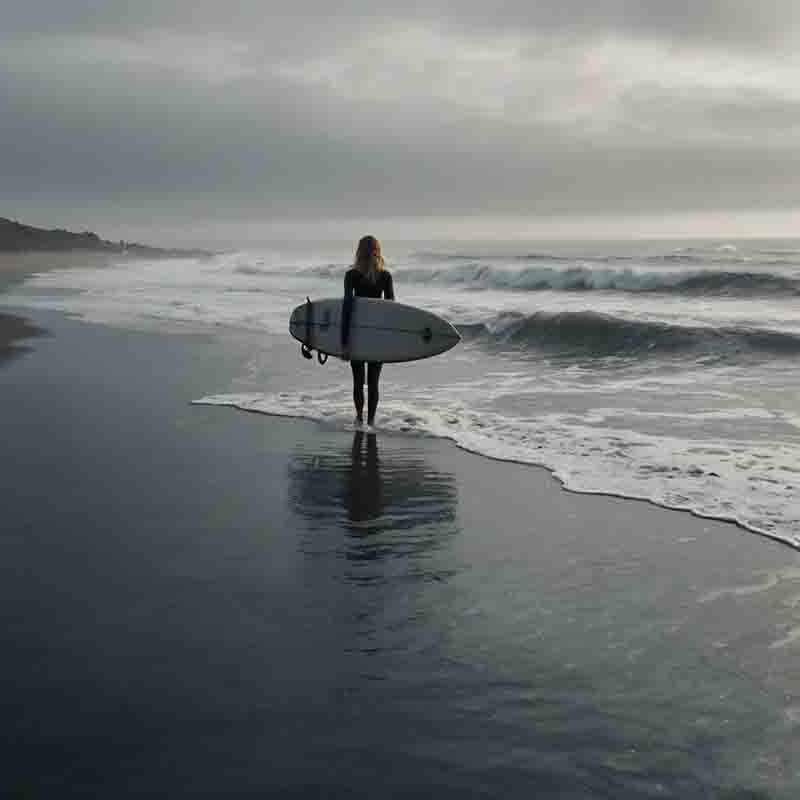
Costa da Caparica, a lengthy stretch of golden beaches just south of Lisbon, is a renowned surfing destination. Its consistent beach breaks cater to all skill levels, from beginners finding their feet in the gentle whitewash to experienced surfers carving along the more powerful waves.
Costa da Caparica has firmly established itself as a premier surfing destination in Portugal.
The Atlantic-facing beaches receive consistent waves year-round, with different sections catering to various skill levels.
Beginners find ideal conditions near Praia de São João, where several surf schools operate daily lessons.
These typically include equipment rental, safety instruction, and hands-on coaching in the water.
Group lessons range from €30-50, while private instruction costs €60-80 per session.
Intermediate surfers head to Praia do Norte, where waves break more consistently and provide longer rides.
During winter months, the surf becomes more challenging, drawing experienced surfers from across Europe seeking bigger waves and fewer crowds.
Local surf shops provide board rentals, wetsuits, and expert advice on daily conditions.
The surfing community in Costa da Caparica welcomes newcomers and creates a friendly, international atmosphere.
Although Costa da Caparica began as a modest fishing village, it has evolved into a well-equipped beach destination while maintaining its Portuguese character.
The town offers all necessary amenities without the overdevelopment seen in some European beach resorts.
The commercial center runs along Avenida 1º de Maio, parallel to the beach.
This main street houses numerous restaurants, cafes, bakeries, and shops selling beachwear, souvenirs, and daily necessities.
During summer months, a lively market operates in the town center, offering fresh produce, clothing, and local crafts.
A pleasant boardwalk stretches along portions of the beach, providing an ideal spot for evening strolls.
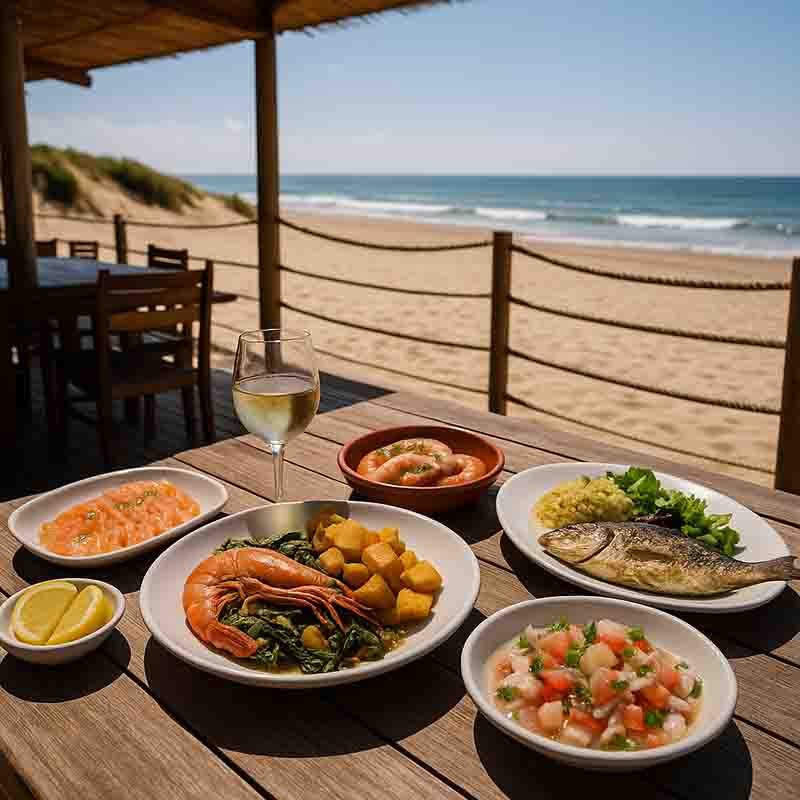
From casual beach bars serving fresh seafood and grilled fish right on the sand, to more refined restaurants offering modern Portuguese cuisine with ocean views, there's something to satisfy every palate in Costa da Caparica.
The culinary offerings in Costa da Caparica celebrate Portugal's rich maritime traditions.
Local fishermen supply restaurants with daily catches directly from the Atlantic, ensuring exceptional freshness and quality.
Beachfront establishments specialize in simply prepared but delicious grilled fish, particularly sardines during summer months.
These typically come served with boiled potatoes, fresh salad, and local olive oil – a perfect meal after a day in the sun.
Bacalhau (salted cod) appears on nearly every menu in various preparations.
Local wines, particularly the crisp vinho verde from northern Portugal, pair perfectly with these seafood specialties.
The climate in Costa da Caparica follows Mediterranean patterns, with distinct seasons affecting the beach experience throughout the year.
May through September provides ideal beach weather with temperatures averaging 25-30°C (77-86°F).
Water temperatures reach their peak in August at around 20°C (68°F), comfortable enough for extended swimming.
July and August represent high season when Portuguese families take their summer vacations.
During these months, beaches become significantly more crowded, particularly on weekends, and accommodation prices increase by 30-50%.
Visitors seeking a more peaceful experience should consider weekday visits during these peak months.
Spring (April-May) and early fall (September-October) offer pleasant weather with fewer crowds.
These shoulder seasons provide a more relaxed atmosphere while still offering warm enough conditions for swimming and sunbathing.
Winter months (November-March) see fewer tourists but attract dedicated surfers seeking bigger waves.
Many beachfront businesses close during this period, though the town remains inhabited and functional year-round.
While sunbathing and swimming remain the primary attractions, Costa da Caparica offers various additional activities for visitors seeking more active experiences.
The Arriba Fóssil da Costa da Caparica Nature Reserve protects the dramatic cliff formations backing the southern beaches.
Hiking trails through this protected area offer stunning views of the coastline and opportunities to observe local flora and fauna, including unique cliff-dwelling plants and seabirds.
Fishing enthusiasts can join local excursions or fish from designated areas along the beaches.
Both recreational and sport fishing attract visitors interested in catching sea bass, bream, and mackerel in the productive Atlantic waters.
Cycling routes connect the town with surrounding areas, including paths along the coast and through nearby pine forests.
Bicycle rental shops provide equipment for exploring these scenic routes at a leisurely pace.
Beach volleyball courts set up along various sections of the coast host informal games welcoming newcomers.
During summer, organized tournaments take place weekly, adding to the lively atmosphere.
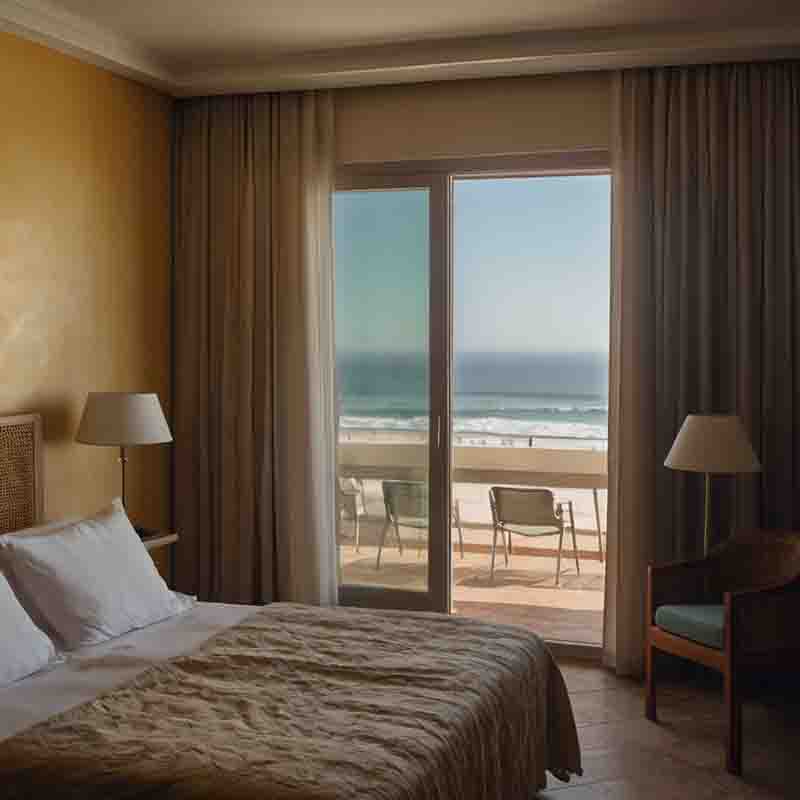
Many accommodations benefit from Costa da Caparica's prime location, offering easy access to the stunning beaches and the vibrant local scene.
Costa da Caparica offers accommodations to suit various preferences and budgets, from luxury to economical options.
Beachfront hotels provide direct access to the sand and sea views from private balconies.
These range from four-star properties with full amenities to simpler hotels focused on location rather than luxury features.
Apartment rentals have grown increasingly popular, particularly for families and groups.
These self-catering options allow for longer stays and provide more space than traditional hotel rooms, often including kitchens and living areas.
Guesthouses operated by local families offer an authentic Portuguese experience.
These smaller establishments frequently include breakfast featuring homemade items and personal recommendations for exploring the area.
Camping sites near the southern beaches provide budget-friendly options for outdoor enthusiasts.
The largest facility, Parque de Campismo Orbitur Costa da Caparica, offers tent and caravan spaces along with basic amenities.
Exploring Costa da Caparica's extensive coastline requires some transportation planning, particularly for reaching the more remote southern beaches.
During summer months, a small tourist train (nicknamed "Transpraia") runs along a dedicated track parallel to the beach.
This service connects the town center with beaches up to 10 kilometers south, making stops at all major beach areas.
The train operates from morning until evening with affordable tickets available for single journeys or day passes.
Local buses provide year-round service between the town center and surrounding areas, including connections to the ferry terminal at Cacilhas for returns to Lisbon.
Taxis and ride-sharing services operate throughout the area, providing flexible transportation options for reaching more remote beaches or nearby attractions.
Many visitors choose to walk or cycle around the immediate area, with rental shops offering bicycles, electric bikes, and scooters for hourly or daily use.
Costa Da Caparica Beaches: Costa Da Caparica is famous for its long stretch of sandy beaches. The coastline spans over 26 kilometers, with beaches suitable for sunbathing, swimming, and water sports. Popular spots include Praia do Castelo, Praia da Morena, and Praia da Princesa. Each offers unique characteristics, from lively beach bars to quieter areas perfect for relaxation.
Surfing in Costa Da Caparica: With consistent waves year-round, Costa Da Caparica is a prime surfing destination. It caters to all skill levels, from beginners learning at surf schools to experienced surfers tackling bigger swells. The best waves usually occur in autumn and winter when the Atlantic produces stronger swells.
Best Restaurants in Costa Da Caparica: Seafood is a highlight here, with fresh fish and shellfish served in many local eateries. Restaurants like O Barbas and Sentido do Mar are well-known for their grilled fish, while places like A Transmontana offer meat-based dishes. There are also beachside cafés serving lighter meals with ocean views.
Weather in Costa Da Caparica: The climate is Mediterranean, with hot summers and mild winters. Summer temperatures often range between 25-30°C (77-86°F), while winter stays around 10-15°C (50-59°F). The area gets plenty of sunshine, making it a year-round destination for outdoor activities.
Things to Do in Costa Da Caparica: Besides the beaches, visitors can explore the Arriba Fóssil da Costa nature reserve, go cycling along the boardwalk, or take boat tours along the Tagus River. There are also cultural sites nearby, such as the Cristo Rei statue in Almada, offering panoramic views of Lisbon.
Hotels in Costa Da Caparica: Accommodation options range from budget-friendly hostels to upscale beachfront hotels. Hotel Costa da Caparica is a popular choice for those seeking comfort and ocean views. There are also smaller boutique hotels and guesthouses for travelers looking for a quieter stay.
Nightlife in Costa Da Caparica: The nightlife scene is laid-back, with beach bars and clubs offering live music and DJ sets. Popular spots include Waikiki Beach Club and Borda D'Água, where people gather for cocktails and dancing by the sea. Lisbon’s vibrant nightlife is also just a short drive away.
Day Trips from Costa Da Caparica: Its location makes it easy to explore nearby attractions. Visitors can take a short trip to Lisbon for historical landmarks, head to Sintra for fairytale palaces, or visit Sesimbra for more coastal scenery and fresh seafood. The Setúbal wine region is also within reach.
Costa Da Caparica Hiking Trails: The Arriba Fóssil da Costa nature reserve offers scenic hiking trails through dunes, cliffs, and forests. These trails provide stunning views of the Atlantic Ocean and are ideal for nature lovers and photographers. Some paths lead to quieter, less crowded beaches.
Public Transport to Costa Da Caparica: The area is accessible from Lisbon by bus, ferry, or car. The TST bus 161 from Praça de Espanha is a direct route, while a ferry from Cais do Sodré to Cacilhas followed by a bus ride offers a scenic alternative. Many visitors also use rideshare services for convenience.
Fishing in Costa Da Caparica: Fishing is a popular activity, with both shore fishing and boat fishing available. Locals often fish along the jetties, catching species like sea bass and bream. Charter boats offer deep-sea fishing trips for those looking to catch larger fish in Atlantic waters.
Costa Da Caparica Boardwalk: A long wooden boardwalk stretches along the coastline, perfect for walks, jogging, or cycling. It connects several beaches and provides easy access to restaurants and bars. Sunset walks here are particularly scenic, with views of the ocean and cliffs.
Beach Bars in Costa Da Caparica: Many beaches have bars and restaurants serving drinks and snacks with ocean views. Praia Irmão, Pé Nú, and Posto 9 are popular choices, offering a mix of cocktails, seafood dishes, and live music. These spots are great for relaxing after a day in the sun.
Family-Friendly Activities in Costa Da Caparica: Families can enjoy safe swimming areas, beach playgrounds, and nature walks. Surf schools offer lessons for kids, and boat tours allow families to explore the coastline. The nearby Mata Nacional dos Medos park provides shaded picnic areas and walking trails.
Best Time to Visit Costa Da Caparica: Summer (June to September) is the peak season, with warm weather and lively beach scenes. For fewer crowds and good surfing conditions, spring and autumn are ideal. Winter is quieter but still pleasant for walks and outdoor exploration.
Surf Schools in Costa Da Caparica: Several surf schools operate in the area, catering to beginners and advanced surfers. Schools like Lisbon Surf Connection and Time To Surf offer lessons with certified instructors. Many provide equipment rental, making it easy for visitors to try surfing without bringing their own gear.
Local Cuisine in Costa Da Caparica: Seafood dominates the menu, with grilled sardines, clams, and octopus being local favorites. The area is also known for its ameijoas à Bulhão Pato (clams in garlic and cilantro sauce) and fresh grilled fish. Many restaurants serve Portuguese pastries like pastéis de nata for dessert.
Costa Da Caparica Hidden Spots: While the main beaches are well-known, some quieter areas include Praia da Mata and Praia da Bela Vista. These spots are less crowded and offer a more peaceful experience. Inland, the Arriba Fóssil cliffs provide a scenic escape from the beachfront crowds.
Photography Spots in Costa Da Caparica: The coastline provides excellent photography opportunities, from golden-hour beach shots to dramatic cliffside views. The Cristo Rei statue viewpoint in nearby Almada offers a spectacular panoramic view of Lisbon, the 25 de Abril Bridge, and the coastline.
Camping Near Costa Da Caparica: There are several camping sites in the area, including Orbitur Costa da Caparica, which offers facilities for tents and caravans. Wild camping is not allowed, but designated campgrounds provide a nature-friendly way to stay close to the beach.
Just a short drive from Lisbon, Costa Da Caparica is where locals go to escape the city and soak up the sun. Whether you’re looking for endless sandy beaches, world-class surf, or fresh seafood with ocean views, this is the place to be.
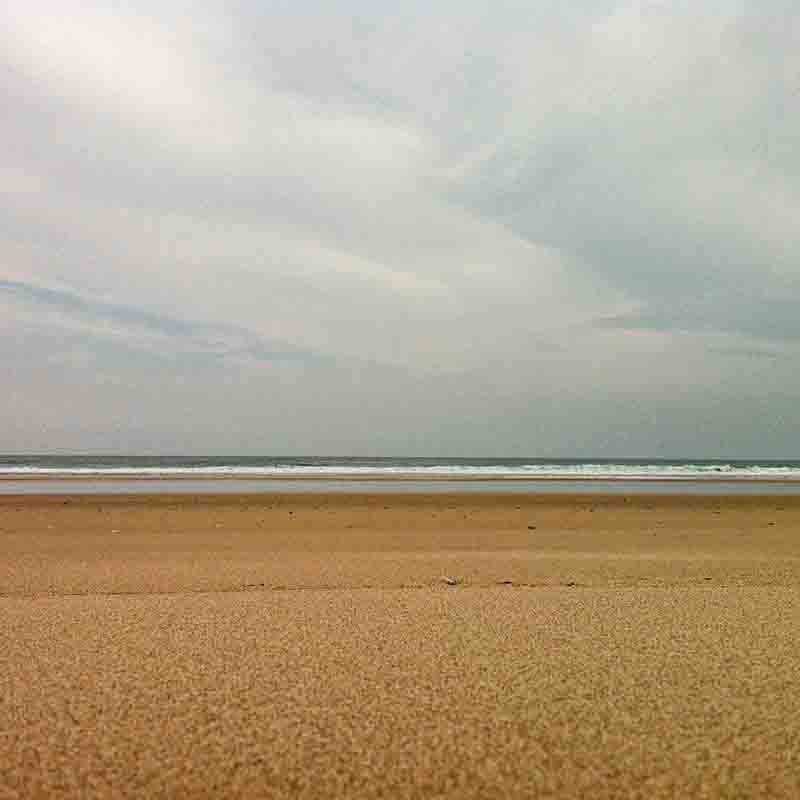
The horizon at Costa da Caparica is a captivating spectacle, where the golden sands meet the vast expanse of the Atlantic Ocean.
Costa da Caparica represents the perfect balance of accessibility and natural beauty.
Its proximity to Lisbon allows for easy visits, while its extensive beaches provide space for everyone from surfers to families.
The town maintains an authentic Portuguese character while offering all necessary amenities for comfortable beach holidays.
Whether you seek active water sports, peaceful sunbathing, fresh seafood dining, or coastal hiking, Costa da Caparica delivers a complete Atlantic beach experience without the overcrowding found at many European coastal destinations.

Your beach escape starts here!